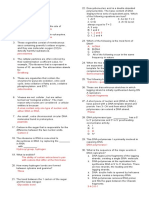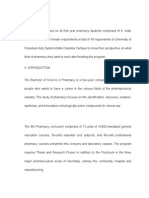100%(1)100% found this document useful (1 vote)
403 viewsNamrata Chhabra, M.D.: Biochemistry For Medics WWW - Namrata.co
Namrata Chhabra, M.D.: Biochemistry For Medics WWW - Namrata.co
Uploaded by
Arshad KhanThe document discusses the monomer units that make up protein polymers. It states that long polypeptide chains of proteins are synthesized from L-amino acids and their derivatives. These amino acids participate in many cellular functions and short amino acid polymers called peptides function as hormones, hormone factors, and neurotransmitters in the neuroendocrine system. The document then goes on to describe the basic structure of amino acids and different ways of classifying them, such as by their side chain properties or metabolic roles. It provides examples to illustrate different amino acid categories.
Copyright:
© All Rights Reserved
Available Formats
Download as PDF, TXT or read online from Scribd
Namrata Chhabra, M.D.: Biochemistry For Medics WWW - Namrata.co
Namrata Chhabra, M.D.: Biochemistry For Medics WWW - Namrata.co
Uploaded by
Arshad Khan100%(1)100% found this document useful (1 vote)
403 views33 pagesThe document discusses the monomer units that make up protein polymers. It states that long polypeptide chains of proteins are synthesized from L-amino acids and their derivatives. These amino acids participate in many cellular functions and short amino acid polymers called peptides function as hormones, hormone factors, and neurotransmitters in the neuroendocrine system. The document then goes on to describe the basic structure of amino acids and different ways of classifying them, such as by their side chain properties or metabolic roles. It provides examples to illustrate different amino acid categories.
Original Description:
G
Original Title
classificationofaminoacids-170325182203
Copyright
© © All Rights Reserved
Available Formats
PDF, TXT or read online from Scribd
Share this document
Did you find this document useful?
Is this content inappropriate?
The document discusses the monomer units that make up protein polymers. It states that long polypeptide chains of proteins are synthesized from L-amino acids and their derivatives. These amino acids participate in many cellular functions and short amino acid polymers called peptides function as hormones, hormone factors, and neurotransmitters in the neuroendocrine system. The document then goes on to describe the basic structure of amino acids and different ways of classifying them, such as by their side chain properties or metabolic roles. It provides examples to illustrate different amino acid categories.
Copyright:
© All Rights Reserved
Available Formats
Download as PDF, TXT or read online from Scribd
Download as pdf or txt
100%(1)100% found this document useful (1 vote)
403 views33 pagesNamrata Chhabra, M.D.: Biochemistry For Medics WWW - Namrata.co
Namrata Chhabra, M.D.: Biochemistry For Medics WWW - Namrata.co
Uploaded by
Arshad KhanThe document discusses the monomer units that make up protein polymers. It states that long polypeptide chains of proteins are synthesized from L-amino acids and their derivatives. These amino acids participate in many cellular functions and short amino acid polymers called peptides function as hormones, hormone factors, and neurotransmitters in the neuroendocrine system. The document then goes on to describe the basic structure of amino acids and different ways of classifying them, such as by their side chain properties or metabolic roles. It provides examples to illustrate different amino acid categories.
Copyright:
© All Rights Reserved
Available Formats
Download as PDF, TXT or read online from Scribd
Download as pdf or txt
You are on page 1of 33
NAMRATA CHHABRA,M.D.
Biochemistry for medics
www.namrata.co
Namrata Chhabra 3/25/2017 1
Provide the monomer units from which the long
polypeptide chains of proteins are synthesized
Namrata Chhabra 3/25/2017 2
L-amino acids and their derivatives participate in cellular
functions as diverse as:
Nerve transmission and the
Biosynthesis of porphyrins,
Purines, pyrimidines, and urea.
Namrata Chhabra 3/25/2017 3
Short polymers of amino acids called peptides perform
prominent roles in the neuroendocrine system as :
hormones,
hormone-releasing factors,
neuromodulators, or
neurotransmitters.
Namrata Chhabra 3/25/2017 4
Each amino acid (except proline) has a carboxyl group, an
amino group and a distinctive side chain bonded to the
alpha carbon atom.
At physiological pH the carboxyl group is dissociated
forming the negatively charged carboxylate ion(-COO-),
and the amino group is protonated(-NH3+)
Namrata Chhabra 3/25/2017 5
Amino acids can be classified in 4 ways:
1. Based on structure
2. Based on the side chain characters
3. Based on nutritional requirements
4. Based on metabolic fate
Namrata Chhabra 3/25/2017 6
1) Aliphatic amino acids
They are classified in three broad categories:
Mono amino mono carboxylic acids They are further
subdivided in 5 groups:
a. Simple amino acids-example: glycine, alanine
b. Branched chain amino acids-e.g.: valine,leucine,isoleucine
c. Hydroxyl group containing amino acids-e.g.: serine, threonine
d. Sulphur containing amino acids-e.g.: cysteine, cystine,
methionine
e. Amide group containing amino acids-e.g.-
asparagine,glutamine
Namrata Chhabra 3/25/2017 7
Mono amino dicarboxylic acid
Example :aspartic acid, glutamic acid
Di /poly amino mono carboxylic acid
Example : lysine, arginine
2) Aromatic amino acids
3) Heterocyclic amino acids
4) Imino acids
5) Derived amino acids
Namrata Chhabra 3/25/2017 8
Simple amino acids: Glycine , Alanine
Namrata Chhabra 3/25/2017 9
Branched chain amino acids: Valine, Leucine and
Isoleucine
Namrata Chhabra 3/25/2017 10
-OH group-containing amino acids: Serine and
Threonine
Namrata Chhabra 3/25/2017 11
Sulfur-containing amino acids: Cysteine, Cystine(Formed
by linking of two cysteine residues) and Methionine.
Namrata Chhabra 3/25/2017 12
Amide group-containing amino acids:
Glutamine and Asparagine
Namrata Chhabra 3/25/2017 13
Aspartic acid and Glutamic acid
Namrata Chhabra 3/25/2017 14
Arginine and Lysine
Namrata Chhabra 3/25/2017 15
Phenyl alanine and tyrosine
Namrata Chhabra 3/25/2017 16
Tryptophan and Histidine
Namrata Chhabra 3/25/2017 17
Proline
Namrata Chhabra 3/25/2017 18
Non-α-amino acids
e.g.: β-alanine, γ-amino butyric acid (GABA), δ-amino Levulinic
acid
Derived and Incorporated in tissue proteins:
e.g.: Hydroxy-proline, hydroxy-lysine
Derived but not incorporated in tissue proteins:
e.g.: Ornithine, Citrulline, Homocysteine, Arginosuccinic acid
Namrata Chhabra 3/25/2017 19
A. Amino acids with a non-polar side-chain:
e.g.: Alanine, Valine, Leucine, Isoleucine, Phenylalanine,
Tryptophan, Proline
Each of these amino acids has a side chain that does
not bind or give off protons or participates in
hydrogen or ionic bonds.
Side chains of these amino acids can be thought of as
“Oily” or lipid like, a property that promotes
hydrophobic interactions.
Namrata Chhabra 3/25/2017 20
Namrata Chhabra 3/25/2017 21
e.g. Serine, Threonine, Tyrosine, Cysteine, Asparagine and Glutamine.
These amino acids are uncharged at neutral pH, although the side chains
of cysteine and Tyrosine can lose a proton at an alkaline pH.
Serine , Threonine and Tyrosine each contains a polar hydroxyl group
that can participate in hydrogen bond formation.
Side chains of Asparagine and Glutamine contain a carbonyl group and
amide group, they can also participate in hydrogen bond formation.
Namrata Chhabra 3/25/2017 22
Namrata Chhabra 3/25/2017 23
a) Amino acids with a positively charged side-chain:
The basic amino acids- Lysine, Arginine and Histidine
b) Amino acids with a negatively charged side-chain:
The acidic amino acids- Glutamic acid and Aspartic acid
They are hydrophilic in nature.
Namrata Chhabra 3/25/2017 24
Namrata Chhabra 3/25/2017 25
I. Essential amino acids:
These amino acids cannot be synthesized in the body and have to be present
essentially in the diet. Examples-
Valine,
Isoleucine,
Leucine,
Lysine,
Methionine,
Threonine,
Tryptophan, and
Phenylalanine.
Namrata Chhabra 3/25/2017 26
II. Semi-essential amino acids:
These amino acids can be synthesized in the body but the
rate of synthesis is lesser than the requirement(e.g.
during growth, repair or pregnancy)
Examples-Arginine and Histidine.
Namrata Chhabra 3/25/2017 27
Non-essential amino acids:
III.
These amino acids are synthesized in the body, thus their
absence in the diet does not adversely affect the growth.
Examples-
Glycine,
Alanine, and the other remaining amino acids.
Namrata Chhabra 3/25/2017 28
The carbon skeleton of amino acids can be used either for glucose
production or for the production of ketone bodies, Based on that
I.Both glucogenic and ketogenic amino acids:
Isoleucine,
Tyrosine,
Phenylalanine and
Tryptophan
Namrata Chhabra 3/25/2017 29
II. Purely Ketogenic amino acids:
Leucine and
Lysine
Namrata Chhabra 3/25/2017 30
II. Purely Glucogenic amino acids:
The remaining 14 amino acids are glucogenic-
Alanine, Valine
Serine, Threonine,
Glycine, Methionine, Cysteine, Cystine,
Asparagine, Glutamine,
Aspartic acid, Glutamic acid,
Histidine and Arginine.
Namrata Chhabra 3/25/2017 31
Of the over 300 naturally occurring amino acids, 20 constitute
the monomer units of proteins.
These 20 amino acids are called the Primary or Standard amino
acids.
Selenocysteine is the 21st Amino Acid
The other are Pyroglutamate and Pyrolysine.
Namrata Chhabra 3/25/2017 32
Namrata Chhabra 3/25/2017 33
You might also like
- Pharmaceutical Dosage FormDocument82 pagesPharmaceutical Dosage FormmagashiayubuNo ratings yet
- Drug InfomationDocument19 pagesDrug InfomationKeith OmwoyoNo ratings yet
- Post Test and CfuDocument13 pagesPost Test and CfuMarie Fatima Quidet UdalbeNo ratings yet
- Filf PDFDocument1 pageFilf PDFArshad KhanNo ratings yet
- Case Study VIDocument1 pageCase Study VIShashidharan MenonNo ratings yet
- Antiviral Drugs: DR Muhammad Sadiq GulDocument21 pagesAntiviral Drugs: DR Muhammad Sadiq GulHasan AnsariNo ratings yet
- Complete Download DiPiro’s Pharmacotherapy: A Pathophysiologic Approach 12th Edition Joseph T. Dipiro PDF All ChaptersDocument66 pagesComplete Download DiPiro’s Pharmacotherapy: A Pathophysiologic Approach 12th Edition Joseph T. Dipiro PDF All Chapterstimsonkalawa100% (8)
- Pharmacology (Green Pacop) Flashcards - QuizletDocument27 pagesPharmacology (Green Pacop) Flashcards - Quizletyeshuavelando13No ratings yet
- Different Types of Glass Containers Used in Pharmaceuticals - Pharmaceutical Guidelines PDFDocument2 pagesDifferent Types of Glass Containers Used in Pharmaceuticals - Pharmaceutical Guidelines PDFRama KumarNo ratings yet
- Emirates International University Faculty of Pharmacy Pharmacoeconomic Lecno3Document27 pagesEmirates International University Faculty of Pharmacy Pharmacoeconomic Lecno3علي الطياريNo ratings yet
- 4 Human Resources Management FunctionsDocument45 pages4 Human Resources Management FunctionsSaddamix AL Omari60% (5)
- PINK PACOP PHARM CALCULATIONS Answer KeyDocument32 pagesPINK PACOP PHARM CALCULATIONS Answer Keyesther samonteNo ratings yet
- Avishkar 2019 PosterDocument1 pageAvishkar 2019 PosterVedant 23 GoogleNo ratings yet
- Pharmaceutical Calculation QN CAT ONEDocument34 pagesPharmaceutical Calculation QN CAT ONEzabronjaphet39No ratings yet
- Pharmaceutical Chemistry of Organic Medicinals Answer Key-GREEN PACOPDocument15 pagesPharmaceutical Chemistry of Organic Medicinals Answer Key-GREEN PACOPDianne LimosNo ratings yet
- BiochemistryDocument135 pagesBiochemistryPradip Hamal100% (1)
- Major DTR 1Document1 pageMajor DTR 1GeraldineMoletaGabutinNo ratings yet
- Lab. 1-Background of The Plant, Preparation of Crude Drug and Official SamplingDocument7 pagesLab. 1-Background of The Plant, Preparation of Crude Drug and Official SamplingRalph Aubrey CulhiNo ratings yet
- Biochemistry PINK PACOPDocument4 pagesBiochemistry PINK PACOPEunice SofiaNo ratings yet
- Medicinal Chemistry I Lab ManualDocument42 pagesMedicinal Chemistry I Lab Manualmagician28No ratings yet
- LECTURE 1 PharmacognosyDocument12 pagesLECTURE 1 Pharmacognosy9s6fgyzyr6No ratings yet
- Kinetics and Drug StabilityDocument92 pagesKinetics and Drug StabilitytesfalemNo ratings yet
- Biochemistry (GREEN)Document18 pagesBiochemistry (GREEN)BRYAN BALDOMERONo ratings yet
- Anti Age Properties of PhytoglycogenDocument2 pagesAnti Age Properties of PhytoglycogenSevres ParisNo ratings yet
- Clinical Pharmacy AdditionalDocument60 pagesClinical Pharmacy AdditionalChia JoseNo ratings yet
- Alkaloids1 160215123735Document35 pagesAlkaloids1 160215123735Daiene Paula100% (1)
- Mycology NotesDocument106 pagesMycology Notesعبدالفتاح البكوشNo ratings yet
- Micropara Lec Unit 1 LaDocument1 pageMicropara Lec Unit 1 LaGrace HernandezNo ratings yet
- Trease and Amp Evans Pharmacognosy 16thDocument1 pageTrease and Amp Evans Pharmacognosy 16thRamya ShahNo ratings yet
- 1 130821233042 Phpapp02Document202 pages1 130821233042 Phpapp02geanNo ratings yet
- Clinical Pharmacy PINK PACOPDocument3 pagesClinical Pharmacy PINK PACOPEunice SofiaNo ratings yet
- Activity 6Document8 pagesActivity 6Kate MendozaNo ratings yet
- Pulmonary Tuberculosis: June 2008Document2 pagesPulmonary Tuberculosis: June 2008kamalab04No ratings yet
- Stroke and HypertensionDocument4 pagesStroke and HypertensionKhessie Laye Garcia JacintoNo ratings yet
- 3.1 Pharmaceutical CalculationDocument16 pages3.1 Pharmaceutical CalculationJoseph Ivan AbaneroNo ratings yet
- Why Kinetics Is Very Important in PharmacyDocument13 pagesWhy Kinetics Is Very Important in PharmacyRavi KantNo ratings yet
- Unit IvDocument10 pagesUnit IvmasorNo ratings yet
- Unit 1: Introduction: Intended Learning OutcomesDocument7 pagesUnit 1: Introduction: Intended Learning Outcomesalibel caballeroNo ratings yet
- Suppositories LectureDocument86 pagesSuppositories Lecturehoneylemon.coNo ratings yet
- #3 Pancreatic Hormones & Antidiabetic Drugs 14 PDFDocument14 pages#3 Pancreatic Hormones & Antidiabetic Drugs 14 PDFOmar BasimNo ratings yet
- Anti LeproticDocument9 pagesAnti LeproticMeenakshi shARMANo ratings yet
- PHAN 1 Lec - Assign 4 - 528294406Document2 pagesPHAN 1 Lec - Assign 4 - 528294406Decimo100% (1)
- Pharmacognosy Assignment 1Document5 pagesPharmacognosy Assignment 1Saud AlamNo ratings yet
- Pharmacology Answer Key-PINK PACOPDocument54 pagesPharmacology Answer Key-PINK PACOPKaguraNo ratings yet
- Pharmaceutical Chemistry II CBSGS Semester VI Pratik BarveDocument4 pagesPharmaceutical Chemistry II CBSGS Semester VI Pratik BarvePt.Govind BhardawajNo ratings yet
- Pha6123 Lab-2nd ShiftingDocument15 pagesPha6123 Lab-2nd ShiftingJANNIE BELLE RODRIGUEZNo ratings yet
- Question Bank SPPU Pharmacognosy Phytochemistry 1 Unit 1Document17 pagesQuestion Bank SPPU Pharmacognosy Phytochemistry 1 Unit 1Kwame OduroNo ratings yet
- Dispensing PracticeDocument86 pagesDispensing PracticeVon Valentine MhuteNo ratings yet
- AutacoidsDocument14 pagesAutacoidsMahmoud AboudNo ratings yet
- Anti-Protozoal Drugs FinalizedDocument54 pagesAnti-Protozoal Drugs FinalizedMoazama Fayyaz100% (1)
- Concepts of Disease OccurrenceDocument24 pagesConcepts of Disease OccurrenceUma Mouna100% (1)
- The Problem and Its Background: Citrofortunella Microcarpa (Calamansi) Is An Important CitrofortunellaDocument50 pagesThe Problem and Its Background: Citrofortunella Microcarpa (Calamansi) Is An Important CitrofortunellaArmylinda LaoagNo ratings yet
- The Perspective of 1st Year BS Pharmacy Students in UPHSDDocument12 pagesThe Perspective of 1st Year BS Pharmacy Students in UPHSDAn LoNo ratings yet
- Group 5 Pdis211 Lab E1Document22 pagesGroup 5 Pdis211 Lab E1Mikaela Kean JoseNo ratings yet
- 1.introduction To Pharmaceutical CalculationDocument36 pages1.introduction To Pharmaceutical CalculationTsegaye NigussieNo ratings yet
- Pharmceutical Chemistry Part 1 (Prelim)Document11 pagesPharmceutical Chemistry Part 1 (Prelim)Majeddah Aliudin TalambunganNo ratings yet
- Metabolism of Phospholipids: Gandham - Rajeev Email:gandhamrajeev33@gmaDocument32 pagesMetabolism of Phospholipids: Gandham - Rajeev Email:gandhamrajeev33@gmaOnSolomonNo ratings yet
- Pharmacology Case StudyDocument4 pagesPharmacology Case StudyRichard S. RoxasNo ratings yet
- Alkaloid - (Chemical Compound) : Families of Flowering PlantsDocument6 pagesAlkaloid - (Chemical Compound) : Families of Flowering Plantswishintamil comNo ratings yet
- Pharmacognosy (A Quick Review) NTS, PPSC & FPSC: Compiled and Typed byDocument9 pagesPharmacognosy (A Quick Review) NTS, PPSC & FPSC: Compiled and Typed byKeziah GillNo ratings yet
- The politics of hunger: Protest, poverty and policy in England, <i>c.</i> 1750–<i>c.</i> 1840From EverandThe politics of hunger: Protest, poverty and policy in England, <i>c.</i> 1750–<i>c.</i> 1840No ratings yet
- MCQ Examples Jan 2016Document30 pagesMCQ Examples Jan 2016Arshad KhanNo ratings yet
- Region Muscle Function Origin Insertion Innervation Blood Supply Anterior ArmDocument4 pagesRegion Muscle Function Origin Insertion Innervation Blood Supply Anterior ArmArshad KhanNo ratings yet
- Dr. ChintanDocument26 pagesDr. ChintanArshad KhanNo ratings yet
- Alkanes Alkenes and AlkynesDocument10 pagesAlkanes Alkenes and Alkynesapi-284299572No ratings yet
- Guide Prof. Vikas Kandekar M.Pharm (Pharmaceutical Chemistry)Document18 pagesGuide Prof. Vikas Kandekar M.Pharm (Pharmaceutical Chemistry)Jyoti ChaturvediNo ratings yet
- Isocyanate PPT BIKASH DUTTADocument15 pagesIsocyanate PPT BIKASH DUTTAmita shil100% (1)
- Exercise C7 - Ans SchemeDocument3 pagesExercise C7 - Ans Schemeknn233610437No ratings yet
- Stereo ChemistryDocument17 pagesStereo ChemistryDeepak PradhanNo ratings yet
- Isopropyl-Alcohol-General, Process, Applications, Products, Patent, Consultants, Company Profiles, Reports, ProjectsDocument4 pagesIsopropyl-Alcohol-General, Process, Applications, Products, Patent, Consultants, Company Profiles, Reports, Projectsshamsullah hamdardNo ratings yet
- PFAS ListDocument6 pagesPFAS ListĐoànKimThoaNo ratings yet
- 45DAYCHECKLIST DexterChemDocument1 page45DAYCHECKLIST DexterChemroyalassassinking2020No ratings yet
- IsomerismDocument62 pagesIsomerismsubesinghNo ratings yet
- Chirality DDDocument130 pagesChirality DDRahul Doc0% (1)
- Substituent Effects in Electrophilic Aromatic SubstitutionDocument10 pagesSubstituent Effects in Electrophilic Aromatic SubstitutionapgajulaNo ratings yet
- Anvisa Regulation On Nitrosamines - Nayrton Flavio Moura Rocha - SlidesDocument33 pagesAnvisa Regulation On Nitrosamines - Nayrton Flavio Moura Rocha - SlidesAlapati RammohanNo ratings yet
- Grade 10 4th Quarter Week 3Document12 pagesGrade 10 4th Quarter Week 3KarenNo ratings yet
- Chapter 6: Organohalogens: Alkyl Halide Vinyl Halide Aryl HalideDocument13 pagesChapter 6: Organohalogens: Alkyl Halide Vinyl Halide Aryl HalidecikguhafidzuddinNo ratings yet
- I. Experiment Title: Aldehyde, Ketone and Carboxylic AcidDocument10 pagesI. Experiment Title: Aldehyde, Ketone and Carboxylic AcidLaily SafitriNo ratings yet
- Handout1 Vaska CompoundDocument5 pagesHandout1 Vaska CompoundMior AfiqNo ratings yet
- Carbohydrate AS Biology Questions OCR AQA EdexcelDocument3 pagesCarbohydrate AS Biology Questions OCR AQA EdexceljanaNo ratings yet
- Chapter 6-Alkylhalide 145 PDFDocument33 pagesChapter 6-Alkylhalide 145 PDFKishore KishoreNo ratings yet
- A2 Chem RattaDocument36 pagesA2 Chem RattaHamzaNo ratings yet
- Introduction To Organic ChemistryDocument114 pagesIntroduction To Organic ChemistryJoefrance MayagmaNo ratings yet
- Cambridge IGCSE Chemistry Topic 14: Organic ChemistryDocument25 pagesCambridge IGCSE Chemistry Topic 14: Organic Chemistryjuned ansariNo ratings yet
- MOC5001 Heterocyclic Chemistry - L1-L4 HandoutDocument33 pagesMOC5001 Heterocyclic Chemistry - L1-L4 HandoutChulaka PitigalaNo ratings yet
- Synthesis and Characterization of Tungsten Carbonyl Complexes Containing ThioamidesDocument7 pagesSynthesis and Characterization of Tungsten Carbonyl Complexes Containing ThioamidesRasel MahfujNo ratings yet
- Phase-Transfer CatalysisDocument16 pagesPhase-Transfer CatalysisSIMARAN JAISWAL 41 M3SNo ratings yet
- Writting Reaction Mechanisms in Organic ChemistryDocument15 pagesWritting Reaction Mechanisms in Organic Chemistrynguyenvanhien2008dhvNo ratings yet
- Unit 2 - Organic BasicsDocument7 pagesUnit 2 - Organic BasicsMalcolmJustMalcolmNo ratings yet
- 1920 CHEM95002 Orbitals 4 - NGP, Rearrangements and FragmentationsDocument17 pages1920 CHEM95002 Orbitals 4 - NGP, Rearrangements and FragmentationsCHEM VIEW POINTNo ratings yet
- Two Hundred Exercises in Mechanistic Organic ChemistryDocument123 pagesTwo Hundred Exercises in Mechanistic Organic ChemistryCông Bằng NguyễnNo ratings yet
- Alcohol's, Phenols & Ethers (MCQ'S)Document2 pagesAlcohol's, Phenols & Ethers (MCQ'S)PATEL AUM S.No ratings yet
- CH 23 StudentDocument33 pagesCH 23 StudentRabin ShresthaNo ratings yet





























































































